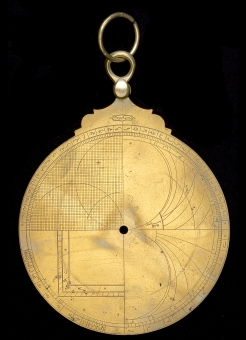| Date | 1713/4 |
| Maker | ‘Abdī |
| Place | Turkey |
| Material | Brass |
| Inventory no. | 39955 |
| Acquisition | Presented by J. A. Billmeir in 1957 |
Astrolabes made in Turkey are comparatively rare: there are only four in the Museum's collection. This is the older of the pair and reflects the simplicity of design and execution of Turkish astrolabes, particularly when compared with contemporary Persian and Indo-Persian instruments. The rete's distinctive strap-work within the ecliptic along with the simple star pointers and clear calligraphic style are characteristic of astrolabes made in Turkey.
The throne and the back of this instrument are of illustrative. The shape of the throne with its clean, unadorned style and almost complete absence of decorative engraving set this astrolabe apart. The inscription, too, echoes this minimalist approach. Set into the centre of the back of the throne, the maker dispensed with formalities, saying simply: ‘Abdī designed this (رسمه علي). The remainder of the back of the instrument has only a small portion of the scales found on contemporary Persian astrolabes and none of the foliate decoration. Notably, there are no astrological tables that crowd the backs of so many Persian astrolabes. The gulf between ‘Abdī's astrolabe and those of contemporary makers is most easily seen by comparing it to some of the instruments made by ‘Abd al-A’imma (see the Related Astrolabes link).
View all
images for this astrolabe
View
detailed provenance for this astrolabe
Mater
The mater and limb are of two pieces, soldered and riveted construction. In the center of the limb is a ring of dots, probably used as a guide for inscribing the numerals on the limb. The rivets that hold the backplate to the limb can be seen approximately every 15° around the limb.. Scales on the limb: degree scale. More informationBack
The back contains 7 scales of the following types: Altitude; Sine/Cosine; Equal hours; Unequal hours; Shadow square; Cotangent; Degree. The back is inscribed: with a date marked as سنه ١١٢٥ (Year 1125). More informationRete, Nut & Bolt
The rete contains 22 stars. The zodiac on the rete is labelled: الڂمل , الثور , الجوزا , السرطان , الاسد , السنبله , الميزان , العقرب , القوس , الجدي , الدلو , الحوت .The rete is attached using a nut & bolt. A recent replacement, which is far too long for this instrument.. More information
Rules & Alidades
| Type | Details |
|---|---|
| Alidade | Double-ended. Decorated with two simple lines running
from one sighting vane to the other.. |



